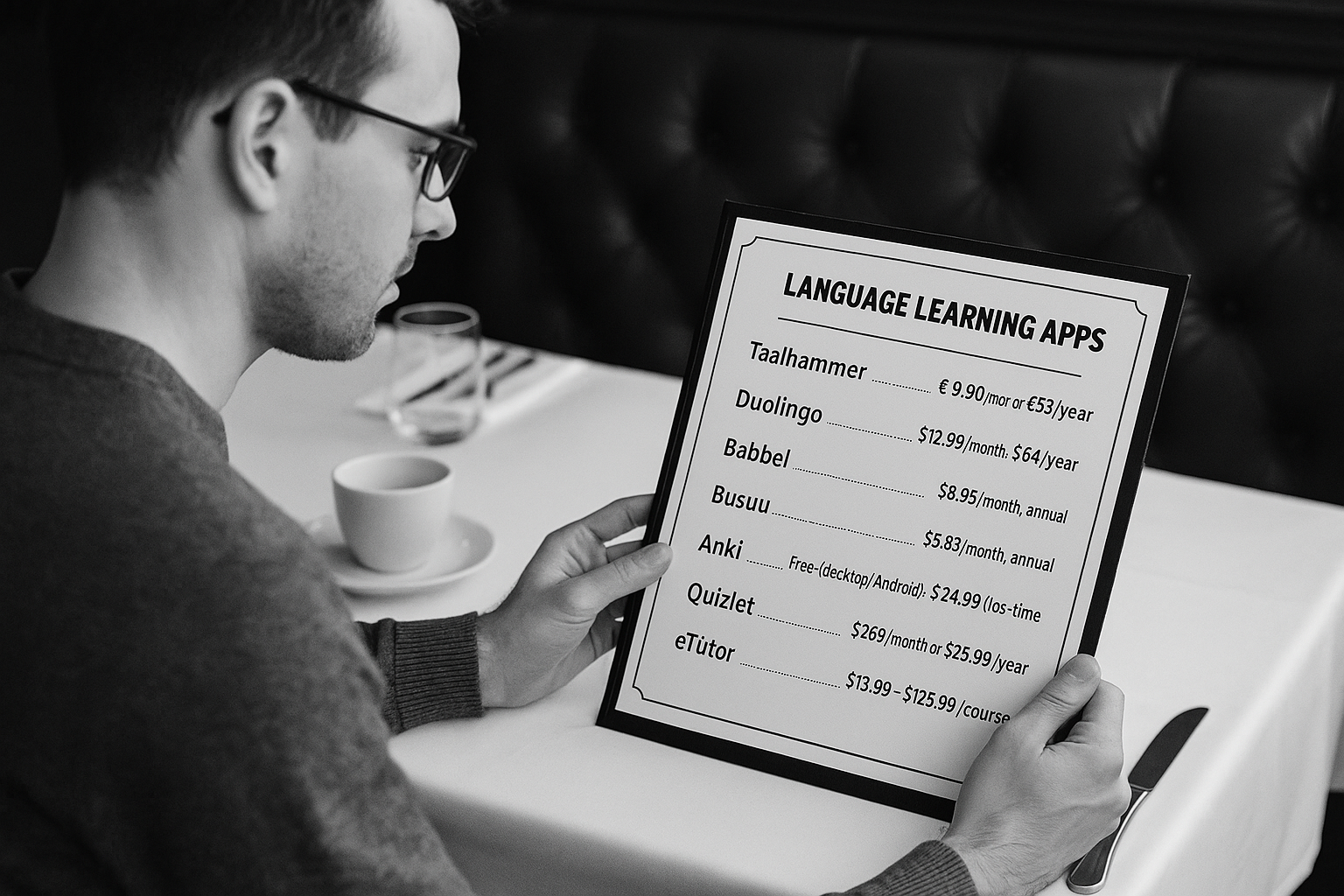Language learning has changed dramatically over the past decade. Today, there are thousands of apps claiming to teach you a language — many of them free or very cheap. But here’s the problem: when something is free, how motivated are you really to stick with it?
In learning a language, commitment and consistency are everything. Sure, saving money matters. But if a language learning app is free, it often comes with hidden costs: limited features, ads, or a lack of depth. Worse, it can make learning feel more like a game than a serious process.
In this guide, I’ll show you the best affordable language learning apps, explain the real differences between free and paid apps, and why sometimes paying a little can massively improve your chances of becoming fluent.
- Free vs Paid Language Learning Apps: Pros and Cons
- Language Learning Apps Prices: 2025 Comparison part 1. Taalhammer vs Duolingo, Babbel, Busuu, Anki, Quizlet and eTutor
- What Makes an App Worth Paying For?
- Commitment: The Hidden Ingredient for Language Learning Success
- Taalhammer’s Approach: Paywall After Trial — Benefit or Barrier?
- Comparison Table: Prices and Features at a Glance
- Choosing the Best Affordable Language Learning App: Final Thoughts
- FAQ: Affordable Language Learning Apps
- Is it worth paying for a language learning app?
- What is the best affordable language learning app in 2025?
- Are free language learning apps effective?
- Which language learning apps offer the best value for the price?
- What’s the difference between monthly, annual, and lifetime subscriptions?
- How long does it take to learn a language with an app?
- Can I reach fluency using only a language learning apps?
Free vs Paid Language Learning Apps: Pros and Cons
Free language apps like Duolingo and Quizlet have exploded in popularity. They’re fun, accessible, and great for getting started. You can learn basic vocabulary, simple phrases, and practice daily.
However, free versions are limited:
- You’ll see ads.
- Advanced content is often locked behind a paywall.
- Speaking and writing practice are usually missing.
- Motivation can drop because you have no real investment.
Many users treat free apps like casual games — logging in for a few minutes a day without serious focus.
What You Get When You Pay
Paid apps unlock a different level of learning:
- Taalhammer offers full access to AI-based spaced repetition, ensuring better memorization.
- Babbel provides structured dialogues and speech recognition.
- Busuu adds peer corrections from native speakers.
With a paid app, you’re investing in:
- Better course structure.
- Full-skill development (speaking, listening, reading, writing).
- Personalization through AI and adaptive learning paths.
This leads to faster progress and better retention.
Are Free Apps Enough for Reaching Fluency?
If you’re aiming for basic survival phrases (A1 level), free apps are fine. But if your goal is fluency (B2 or C1), free apps almost never deliver.
Studies show that dropout rates are higher for users of free apps compared to those who pay. Paying even a small monthly fee creates a psychological commitment — it’s no longer “just for fun,” it’s an investment. It’s just like when you go to a therapist. Many specialists require payment even if you cancell your appointment, allowing only for 2 or 3 free cancellations a year. This is because people are more likely to treat something seriously if they have to pay for it.
Language Learning Apps Prices: 2025 Comparison part 1. Taalhammer vs Duolingo, Babbel, Busuu, Anki, Quizlet and eTutor
Choosing the right language learning app isn’t just about the features — it’s also about finding one that fits your budget. In this part, I’ll compare the prices and core features of some of the most popular and effective language learning apps on the market today.
This is Part 1 of the comparison, focusing on well-known names like Taalhammer, Duolingo, Babbel, and Busuu. Coming up in Part 2: We’ll take a closer look at more language learning apps — including newer and niche platforms — to help you find the best fit for your goals and budget. Stay tuned for the full comparison!
Updated Pricing Overview
| App | Price | Free Options |
|---|---|---|
| Taalhammer | €9.90/month or €59/year | 7 days trial |
| Duolingo | $12.99/month or $84/year | Free version |
| Babbel | $8.95/month (annual) | 20 days refund guarantee |
| Busuu | $5.83/month (annual) | 14 days trial |
| Anki | Free (desktop/Android); $24.99 (iOS one-time) | No trial |
| Quizlet | $7.99/month or $35.99/year | Free version |
| eTutor | $13.99 – $129.99/course | Varies |
What’s Included at Each Price Level
- Taalhammer: AI, full language skills, no ads, real course structure.
- Duolingo: AI features in Super Duolingo; limited speaking practice.
- Babbel: Conversational practice, speech recognition, grammar explanations.
- Busuu: Speaking practice with community corrections, grammar units, certification.
- Anki: Custom flashcards, self-study, full spaced repetition system (free).
- Quizlet: Smart flashcard study paths, ad-free experience.
- eTutor: Full-level courses, grammar explanations, speaking activities.
Subscription Types Explained
- Monthly subscriptions offer flexibility — you can cancel anytime — but they tend to be the most expensive option if you plan to study for more than a few months. For example, paying month-to-month can easily double your yearly cost compared to annual plans.
- Annual subscriptions are a smarter choice for serious learners. They require a bigger upfront payment but bring significant savings in the long run. For instance, Taalhammer’s annual plan costs just €59, which breaks down to about €4.90 per month — almost half the price of many monthly rates. Annual plans are ideal if you’re committed to steady progress over a year.
- Lifetime plans are even better for long-term learners who plan to study multiple languages or maintain skills over several years. Apps like Babbel often offer lifetime access for $299 to $399, sometimes with discounts bringing it closer to $199–$259 during promotions. A lifetime plan means one upfront payment for unlimited use — a valuable option if you see language learning as a long-term goal.
What Makes an App Worth Paying For?
Choosing a language learning app isn’t just about finding the cheapest option — it’s about getting real value for your time and effort. The best apps do more than teach vocabulary; they build full language skills with structured methods and smart technology. Let’s look at what really makes an app worth the investment.
Real Skill-Building vs. Gamified Practice
An app should help you speak, read, write, and listen — not just collect points or maintain streaks. Taalhammer, Babbel, and Busuu focus on these full skills, unlike many free alternatives.
The Role of Technology
Technology plays a crucial role in modern language learning. Artificial Intelligence (AI) and Spaced Repetition Systems (SRS) are powerful tools that help you remember words, phrases, and grammar rules more effectively by reviewing material at just the right time. Instead of passive memorization, these systems actively reinforce what you learn, speeding up retention and reducing forgetting.
See which apps are supported by AI in this article: The best language learning app supported by AI? Check out how Taalhammer compares to the competition [2025]
Structured Progression Paths
A clear learning path is essential if you want to move beyond the basics. Reaching levels like A2, B1, or B2 requires more than random lessons — it takes a structured curriculum that builds skills step by step. Apps like Taalhammer and Babbel design their programs to guide you through vocabulary, grammar, speaking, and comprehension in a logical sequence.
By tracking your progress and gradually increasing the difficulty, these apps help ensure steady, measurable improvement. You always know where you are and what comes next, which keeps motivation high and prevents you from getting stuck or overwhelmed. A structured progression isn’t just helpful — it’s key to reaching real fluency.
Commitment: The Hidden Ingredient for Language Learning Success
The Psychology of Paying
Behavioral studies consistently show that when we invest money into something, we are more likely to stay committed. It’s the same reason people are less likely to skip a gym session they’ve paid for, compared to a free class they can easily ignore. The act of paying, even a small amount, creates a sense of obligation and value. When it comes to language learning, paying for an app nudges you toward consistent study habits and keeps you engaged long enough to see real progress.
Free vs Paid: Engagement and Dropout Rates
Data reveals that free app users are 2–3 times more likely to abandon their learning after the first few weeks. Paying customers stick with it longer, complete more lessons, and are more likely to reach conversational proficiency.
Learning a Language vs. Playing a Game
Apps like Duolingo make language learning feel like a game — short, colorful, and rewarding in the moment. While this approach can be fun and motivating at first, it often leads to superficial progress, focused more on maintaining streaks or earning points than building real, lasting skills.
Paid apps, by contrast, are designed with more structure and long-term goals in mind. They prioritize real skill development — speaking, writing, understanding grammar — over quick wins. Instead of just keeping you entertained, they help you stay focused on the real objective: mastering a new language.
Taalhammer’s Approach: Paywall After Trial — Benefit or Barrier?
7-Day Trial: A Preview of the Full Experience
Taalhammer gives you 7 days to try everything: all language collections, AI-driven practice tools, and full access to exercises — with no credit card required. This open approach builds trust by letting users fully experience the platform before committing. After the trial ends, continued access requires a subscription, promoting serious learning without the endless limitations or distractions typical of freemium models.
No Freemium Tactics: Focus on Commitment
This is where Taalhammer stands out. Unlike apps that lure you with free features but restrict real progress, Taalhammer asks for commitment early. It filters out users who aren’t serious — a model similar to coaching programs and therapy sessions, where paying ensures people stay invested.
Why Paying Boosts Language Learning Success
When you pay, you are more likely to:
- Stick to a regular study schedule.
- Complete full modules.
- Reach actual language proficiency.
Taalhammer’s design uses this commitment model to help learners progress faster and more effectively.
Comparison Table: Prices and Features at a Glance
| App | Price |
|---|---|
| Taalhammer | €9.90/month or €59/year |
| Duolingo | $12.99/month or $84/year |
| Babbel | $8.95/month (annual plan) |
| Busuu | $5.83/month (annual plan) |
| Anki | Free (desktop/Android) / $24.99 iOS one-time |
| Quizlet | $7.99/month or $35.99/year |
| eTutor | $13.99–$129.99 per course |
Taalhammer
- Speaking Practice: Yes
- Writing Practice: Yes
- AI Support: Yes
- Certification: Yes
Duolingo
- Speaking Practice: No
- Writing Practice: No
- AI Support: Yes
- Certification: No
Babbel
- Speaking Practice: Yes
- Writing Practice: Yes
- AI Support: Yes
- Certification: Yes
Busuu
- Speaking Practice: Yes
- Writing Practice: Yes
- AI Support: Yes
- Certification: Yes
Anki
- Speaking Practice: No
- Writing Practice: Yes (DIY with flashcards)
- AI Support: Yes
- Certification: No
Quizlet
- Speaking Practice: No
- Writing Practice: Yes
- AI Support: Yes
- Certification: No
eTutor
- Speaking Practice: Yes
- Writing Practice: Yes
- AI Support: No
- Certification: Yes
Choosing the Best Affordable Language Learning App: Final Thoughts
Language learning is a journey — one that requires time, energy, and, yes, a little money. Free apps might get you started, but they rarely get you fluent.
Paying for a serious app is an investment — not just in the app, but in yourself. Taalhammer’s paid model ensures you commit early, increasing your chance of real success.
If you’re serious about mastering a language, pick an app that respects your time and your goals. Affordability is important — but value for money and commitment are what truly make the difference.
Make sure to read part 2 in which I compare Italki, Lingvist, LingQ, Drops, Glossika, Rosetta Stone.
FAQ: Affordable Language Learning Apps
Is it worth paying for a language learning app?
Yes, paying for a language learning app is often worth it if you’re serious about making real progress. Free apps are good for casual practice, but paid apps usually offer full skill development — including speaking, writing, grammar, and personalized learning paths — which are essential for reaching higher proficiency levels.
What is the best affordable language learning app in 2025?
Taalhammer stands out as one of the best affordable language learning apps in 2025. With full access to AI-driven repetition systems, structured lessons across all skills, and a cost-effective annual plan (€59/year), it offers serious value for committed learners. Other good options include Babbel and Busuu, depending on your learning goals.
Are free language learning apps effective?
Free language learning apps can be effective for beginners or casual learners, but they often lack depth in speaking, writing, and grammar practice. Studies show that users are more likely to stick with a learning plan and achieve fluency when they invest in a paid app, due to higher engagement and better course structure.
Which language learning apps offer the best value for the price?
Apps like Taalhammer and Busuu offer excellent value, combining reasonable prices with a full range of learning features. They support speaking, writing, listening, and reading, and often include AI-based learning plans and certification options — all at a much lower cost compared to traditional courses or tutors.
What’s the difference between monthly, annual, and lifetime subscriptions?
Monthly subscriptions give flexibility but are more expensive over time. Annual plans, like Taalhammer’s €59/year deal, offer big savings for long-term learners. Lifetime subscriptions, available from apps like Babbel for around $299–$399, are ideal for those planning to learn multiple languages or maintain skills over several years.
How long does it take to learn a language with an app?
It depends on your commitment, the language’s difficulty, and the app’s structure. With consistent daily practice, many users can reach conversational levels (B1/B2) in 6–12 months. Apps with structured progressions and full-skill coverage, like Taalhammer or Babbel, can help you move faster than casual or game-based apps. Read this article to find out How long does it take to learn a foreign language? And how to accelerate it with Taalhammer
Can I reach fluency using only a language learning apps?
Language apps are a powerful tool, but reaching full fluency usually requires combining app practice with real-world exposure, such as speaking with native speakers, reading books, or consuming media in the target language. Apps that cover all skills and offer structured progression greatly improve your chances of reaching fluency.








